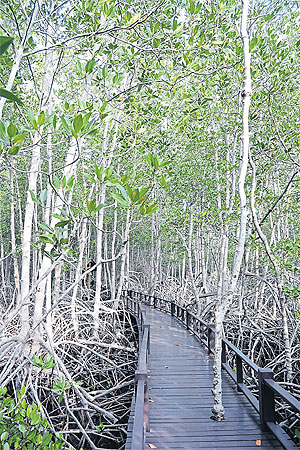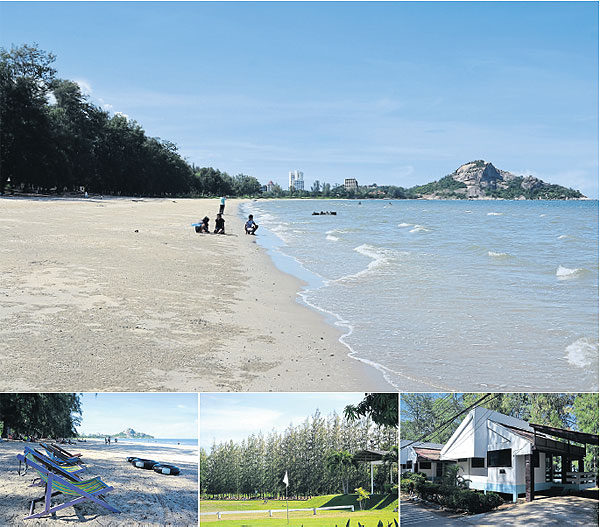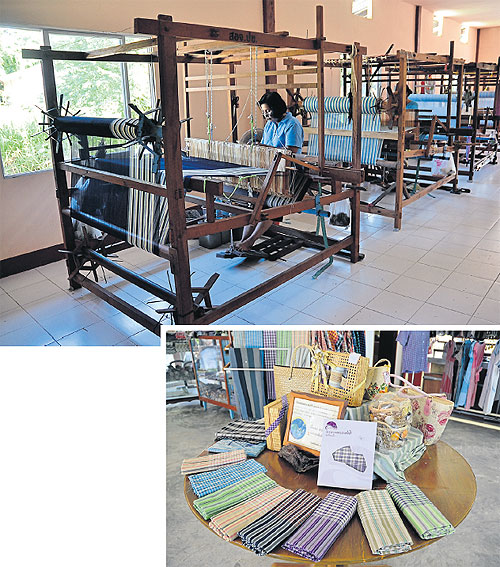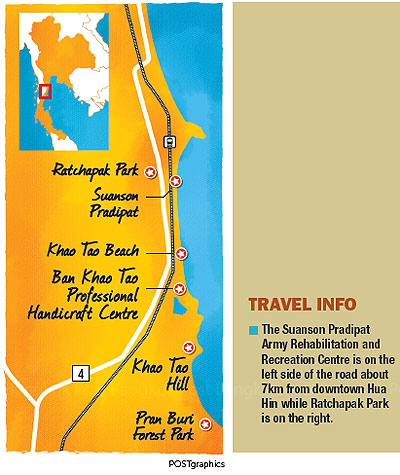More Wonders of Hua Hin
Located on an army-owned plot covering 222 rai in Hua Hin,
Ratchapak Park and the statues of seven former Thai kings were
constructed by the Royal Thai Army under royal permission from His
Majesty King...
Just south of the resort town there is a lot more for visitors to explore ranging from forests to majestic statues
As the resort town of Hua Hin has grown rapidly
over the past decade, it often has new tourist destinations and
activities to offer. Strolling along the beach, swimming, sunbathing,
horse riding, playing watersports, worshipping Thailand's largest statue
of the late revered monk Luang Pu Thuad at Wat Huay Mongkol and
enjoying beautiful sea views with cool sea breezes are what
holidaymakers love to do there.
Nonetheless, if all these things are no longer interesting, tourists
may want to travel 7km south from downtown Hua Hin to worship the
gigantic statues of seven great Thai kings at the new Ratchapak Park
opposite the tranquil Suanson Pradipat beach.This beach won four out of five stars under the Pollution Control Department's beach quality index in 2012.
Swimming, relaxing, dining or playing golf nearby the ironwood-lined beach, strolling the adjacent Khao Tao beach and visiting the hilltop Wat Khao Tao are also recommended for those visiting the lower part of Hua Hin. In addition, tourists can visit the scenic Khao Tao reservoir and the first royally-initiated weaving project at Ban Khao Tao village. If they travel about 5km southwards, they will reach the nearby Pran Buri Forest Park where they can stroll a mangrove forest study route and a few more nature trails and stay overnight in the camping zone.
On their way back home, visitors may want to buy local products as souvenirs for family and friends. Among its highly recommended products are Hua Hin's signature Khomapastr printed cotton fabrics and Ban Khao Tao's cotton textiles which are unique for their weaving techniques and silk-like textures.
Nestled by the Gulf of Thailand in Prachuap Khiri Khan, less than 200km south of Bangkok, Hua Hin, literally meaning "rocky beachhead", was named after the rocks at the north end of the 5km-long sandy beach.
This small fishing village became the country's first beach resort after a rail line was laid in the 1920s and King Rama VII established his summer palace there. For almost a century, it has been a popular weekend getaway destination for city dwellers, royals and the elites.
"The entire province of Prachuap Khiri Khan including Hua Hin attracts 4.6 million tourists each year.
"In Hua Hin, Thais enjoy leisure tourism that incorporates resting and eating seafood. Foreigners also come to relax. They want a peaceful, not vibrant, atmosphere to take things easy," said Orasa Awutkom, director of the Tourism Authority of Thailand (TAT)'s Prachuap Khiri Khan Office.
According to her, tourism in Hua Hin, however, has begun to reach saturation point and is expanding to places such as Pran Buri which have attracted more people who like slow tourism. In line with the TAT's focus on sustainable tourism, Prachuap Khiri Khan has numerous attractions to offer. For instance, Pran Buri is home to Sirinart Rachini Mangrove Ecological Study Centre and is famous for surfboarding, while sailing in Thab Sakae and diving off Koh Thalu are popular.
"Beaches in Prachuap Khiri Khan are very beautiful. Tourist attractions in military zones are well-developed and won about five stars for beach quality from the Department of Pollution Control," Orasa added.

 Pran Buri Forest Park was established in 1974 by the Forestry
Department after Her Majesty Queen Sirikit visited Pak Nam Pran Buri
Village in Pran Buri district, saw many mangrove trees and wanted to
support the growing of more trees along the coastline. This special
project developed 1,984 rai of Khlong Kao and Khlong Doi forests — which
consists of mangrove forests, mixed deciduous forests, coastal land and
deserted land — into a multipurpose forest. Later in 1982, the
department declared this area a forest park because it has a beautiful
beach as well as mangrove and mixed deciduous forests running alongside
the Pran Buri River. In 2003, Their Majesties the King and Queen visited
Pran Buri Forest Park and expressed their concern for the forests,
especially the mangrove forests. Here, visitors will be able to enjoy
birdwatching, camping by the sea, trekking the dry evergreen forest on
the Chao Phor Hua Laem Hill and strolling the 1km-long mangrove forest
study route. This forest park has various kinds of plants and wild
animals, such as monkeys, barking deer, snakes and lizards. From the
1km-long Pran Khiri beach, the scenic views of Tao and Singto islands
and Khao Takiab and Khao Tao hills can be seen.
Pran Buri Forest Park was established in 1974 by the Forestry
Department after Her Majesty Queen Sirikit visited Pak Nam Pran Buri
Village in Pran Buri district, saw many mangrove trees and wanted to
support the growing of more trees along the coastline. This special
project developed 1,984 rai of Khlong Kao and Khlong Doi forests — which
consists of mangrove forests, mixed deciduous forests, coastal land and
deserted land — into a multipurpose forest. Later in 1982, the
department declared this area a forest park because it has a beautiful
beach as well as mangrove and mixed deciduous forests running alongside
the Pran Buri River. In 2003, Their Majesties the King and Queen visited
Pran Buri Forest Park and expressed their concern for the forests,
especially the mangrove forests. Here, visitors will be able to enjoy
birdwatching, camping by the sea, trekking the dry evergreen forest on
the Chao Phor Hua Laem Hill and strolling the 1km-long mangrove forest
study route. This forest park has various kinds of plants and wild
animals, such as monkeys, barking deer, snakes and lizards. From the
1km-long Pran Khiri beach, the scenic views of Tao and Singto islands
and Khao Takiab and Khao Tao hills can be seen. Located in Ban Nong Kae, Hua Hin, about 190km from Bangkok, the
Suanson Pradipat Army Rehabilitation and Recreation Centre has been in
service since 1970. It is home to a beautiful, clean and peaceful beach.
It offers bungalows and a camping area for army officers, families and
the general public to rent at reasonable prices. It also has a golf
practising centre, running tracks, restaurants, meeting rooms and food
centres. The rates of bungalows per room per night range from 110 baht
for army officers and families and 220 baht for the general public for
dormitories to 1,850 baht for army officers and families and 3,700 baht
for the general public for a three-bedroom bungalow.
Located in Ban Nong Kae, Hua Hin, about 190km from Bangkok, the
Suanson Pradipat Army Rehabilitation and Recreation Centre has been in
service since 1970. It is home to a beautiful, clean and peaceful beach.
It offers bungalows and a camping area for army officers, families and
the general public to rent at reasonable prices. It also has a golf
practising centre, running tracks, restaurants, meeting rooms and food
centres. The rates of bungalows per room per night range from 110 baht
for army officers and families and 220 baht for the general public for
dormitories to 1,850 baht for army officers and families and 3,700 baht
for the general public for a three-bedroom bungalow. Located in soi Hua Hin 101, the Ban Khao Tao Professional Handicraft
Centre was previously called the Ban Khao Tao Weaving Training Centre.
It is a royal project initiated by Their Majesties the King and Queen.
It dates back to 1964 when Their Majesties the King and Queen were
staying at Klai Kangwon Palace, Hua Hin, and visited Ban Khao Tao’s
villagers who were then mostly fishermen. After learning that the
villagers could not earn their living during the rainy season,
especially the monsoon period, His Majesty King Bhumibol Adulyadej
ordered that a class be organised for lecturers to teach the art of
cotton weaving using traditional northern looms called kee kratook for
the residents of Ban Khao Tao and nearby villagers. Their Majesties the
King and Queen visited the centre four times. The group currently has 25
members, eight of whom are active. Woven with fine 100% cotton thread,
fabrics from Ban Khao Tao are of a distinctive quality and allow air to
pass through them. Visitors should not miss the unique pha khao ma
clothes woven with nine horizontal threads. In addition, handmade
fabrics with floral designs (yok dok) are durable and as shiny as silk.
Located in soi Hua Hin 101, the Ban Khao Tao Professional Handicraft
Centre was previously called the Ban Khao Tao Weaving Training Centre.
It is a royal project initiated by Their Majesties the King and Queen.
It dates back to 1964 when Their Majesties the King and Queen were
staying at Klai Kangwon Palace, Hua Hin, and visited Ban Khao Tao’s
villagers who were then mostly fishermen. After learning that the
villagers could not earn their living during the rainy season,
especially the monsoon period, His Majesty King Bhumibol Adulyadej
ordered that a class be organised for lecturers to teach the art of
cotton weaving using traditional northern looms called kee kratook for
the residents of Ban Khao Tao and nearby villagers. Their Majesties the
King and Queen visited the centre four times. The group currently has 25
members, eight of whom are active. Woven with fine 100% cotton thread,
fabrics from Ban Khao Tao are of a distinctive quality and allow air to
pass through them. Visitors should not miss the unique pha khao ma
clothes woven with nine horizontal threads. In addition, handmade
fabrics with floral designs (yok dok) are durable and as shiny as silk. In 1963, His Majesty King Bhumibol Adulyadej visited the residents of
Hua Hin district and noticed hardships faced by those living in Ban
Khao Tao Village in tambon Nong Kae. This community was highly
populated, but lacked water for consumption. During the time of high
tides, farmland was inundated with seawater in the Thung Takad field in
this tambon and thus crops were damaged. As the local villagers gave him
a 300 rai land plot in the village, HM the King granted 60,000 baht of
his personal money to the Department of Royal Irrigation for building a
reservoir. This Khao Tao Reservoir Project is considered the first
royally-initiated project run by this department. The reservoir
initially had the capacity of keeping 600,000³ of water. HM the King
also supported the construction of Wat Khao Tao in 1958 and opened this
temple in 1961.
In 1963, His Majesty King Bhumibol Adulyadej visited the residents of
Hua Hin district and noticed hardships faced by those living in Ban
Khao Tao Village in tambon Nong Kae. This community was highly
populated, but lacked water for consumption. During the time of high
tides, farmland was inundated with seawater in the Thung Takad field in
this tambon and thus crops were damaged. As the local villagers gave him
a 300 rai land plot in the village, HM the King granted 60,000 baht of
his personal money to the Department of Royal Irrigation for building a
reservoir. This Khao Tao Reservoir Project is considered the first
royally-initiated project run by this department. The reservoir
initially had the capacity of keeping 600,000³ of water. HM the King
also supported the construction of Wat Khao Tao in 1958 and opened this
temple in 1961.
About the author
 Writer: Pichaya Svasti
Writer: Pichaya Svasti
Position: Life Writer


ไม่มีความคิดเห็น:
แสดงความคิดเห็น